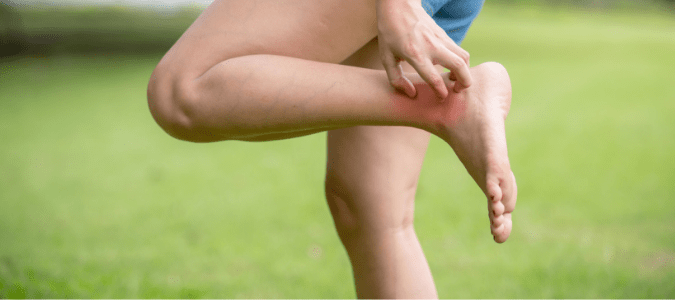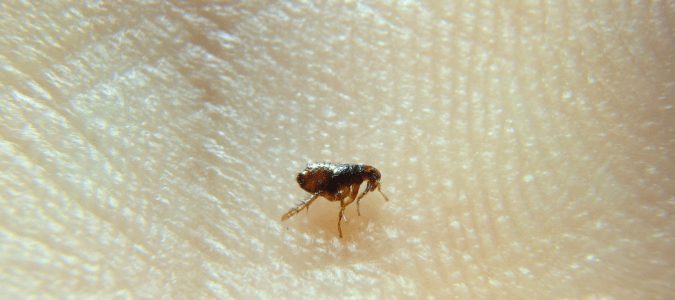Can flea bites make you sick? This is a question many people ask when dealing with a flea infestation at home. After all, it’s tough to believe such a tiny creature could make you physically ill. But, unfortunately, flea bites actually can cause health problems for humans and their pets.
Fortunately, it’s pretty rare for people to get seriously ill from flea bites, but it’s not impossible. Flea bites typically leave little, pinkish-red spots or welts on the skin that may be incredibly itchy. Flea bites tend to be smaller in size than mosquito bites and often appear either in a straight line or in groups of three or four. Since fleas don’t have wings, they move around by crawling or jumping, but they can only jump about a foot high. This is why people often find flea bites clustered on their feet and ankles; the insects can’t jump much higher than that!
While most people won’t suffer any problems from flea bites other than how itchy they are, some will. Fleas are carriers of potentially dangerous diseases and parasites like murine typhus and tapeworms, which can be transmitted to humans. Flea bites can also cause secondary infections. For example, if people scratch their bites too much and break the skin, they can wind up contracting staph or MRSA. Although it’s not very common, it is possible.
Fleas can also make pet owners sick through contact with their furry friends. For example, fleas can cause cat scratch fever in cats. Then, the infected cat can pass the illness along to its human companion through bites or scratches that break the skin. Murine typhus works the same way—fleas carry this type of bacteria and pass it along to pet. Then, the pets transmit the bacteria to their people.
As for tapeworm, dogs and cats are more likely to contract tapeworm from fleas than people are, since the infected flea has to be swallowed. This can happen when flea-infested pets groom themselves. While it’s rare for people to contract tapeworms from fleas, it’s not unheard of. For example, kids playing outside might unknowingly cross paths with fleas carrying tapeworms. Then, they can accidentally ingest a flea when putting dirty hands in their mouths.
That said, it’s more likely for flea bites to cause illness in pets than in people. Pets often pick up fleas when they spend time outside, where wild animals carry fleas that can then transfer to domesticated animals. Pets can develop severe allergic reactions to flea bites. If you notice your pet scratching a lot, check its fur for signs of fleas.
Signs of Fleas on Pets
You might be able to identify fleas—tiny, dark-brown insects that can move surprisingly fast through the pet’s fur—or “flea dirt.” Actually flea feces, flea dirt looks like tiny, black specks of dirt on an animal’s skin or in its fur. You’re likely to find flea dirt at the base of the hairs close to the skin. You might also spot flea bites on your pet’s skin, especially around its belly or the tops of its back legs. Flea bites typically look like pink or red swollen welts.
If an animal has an allergic reaction to flea bites, its skin could be pink and swollen beyond just the bite sites. You may also notice your pet has flaky skin or is missing patches of fur due to excessive scratching. Flea bites can cause anemia in dogs and cats. Pets can even develop emotional problems from too many flea bites, including anxiety and obsessive-compulsive behaviors. Your pet’s veterinarian can help diagnose and resolve these kinds of problems. That said, it’s good to be aware of the signs so you’ll know if it’s time to have your furry friend checked out.
The somewhat good news is, for most people, the worst thing about flea bites is the itchy discomfort they cause. For others, however, flea bites can lead to much bigger problems. It can also be tough to determine whether you’ve been bitten by a flea, a tick, a spider, a bed bug or something else. Worst of all, when fleas aren’t dealt with quickly, their populations can grow fast, making them that much harder to eliminate.
For all these reasons, the best way to get rid of fleas is often with the help of a professional. Pest management specialists are experienced with fleas and know how to treat these pests in all stages of their life cycle. A professional also knows how to treat every area of the home and yard that may be hosting fleas. Knowing the problem is being addressed can restore peace of mind and enable you to enjoy your home and yard once again.
If you’ve heard that light can be used in the fight against fleas, you may have wondered if this method can really work. Keep reading to find out.
Are Fleas Attracted To Light?
If you are curious about whether light can attract fleas, you should know that the short answer is that adult fleas are attracted to both light and warmth. This means light traps can be one effective tool in a comprehensive approach to getting rid of fleas. But these traps should never be the only tool used to get rid of fleas, because they aren’t enough, by themselves, to control an entire infestation.
Fleas find their hosts in part by detecting warmth and carbon dioxide rising off their bodies. This is one reason why flea traps involving light can be helpful in getting rid of fleas. Electric light flea traps can be purchased at home improvement stores. These traps work by shining a warm light source down onto a sticky surface that traps fleas jumping toward the light. Some people set up their own do-it-yourself light traps by positioning a lamp on the floor over a bowl of water with soap in it. The idea is that the soap breaks the water’s surface tension. When the lamp is a few inches above the bowl of water and fleas jump toward the light, they land in the bowl of water, sink below the surface due to the soap and drown. As you might imagine, if you have an active—and growing—flea population, you’d have to have many, many traps to make a noticeable impact on the problem.
Since adult fleas are attracted to warmth and light, light traps can work to attract and trap some adult fleas. The problem with light traps, though, is that they only work for adult fleas. They don’t address flea eggs, larvae or pupae. In fact, flea larvae actually avoid light. Killing off only adult fleas won’t stop a flea infestation in your home. All stages of the flea life cycle will need to be addressed in order to resolve a flea problem.
There are some simple steps people can take to help fight against fleas in the home. These steps include:
- vacuuming frequently,
- washing your own sheets and any pets’ bedding regularly,
- using a flea comb on your pets and
- having your pets treated for fleas by a veterinarian.
Setting up light traps can also help. However, don’t expect these simple measures to be enough to get rid of fleas that have already taken over your home and yard. Fleas can quickly become unmanageable, so enlisting professional help is the best step you can take to control an infestation.
While you know how to do simple tasks such as vacuuming and washing your bedding, using a flea comb may be a whole new experience for you. It’s important to learn how to use a flea comb properly if you want it to aid in your flea control process.
How To Use a Flea Comb
If your dog or cat has fleas, you might wonder what’s the best way to get rid of the pests as quickly as possible. Should you get Fido a flea collar, give him a bath with medicated shampoo or ask the vet for a prescription for oral flea medicine? Any and all of these might be helpful or even necessary, but don’t forget about using a flea comb! This type of comb has lots of closely spaced teeth to catch and remove fleas, dirt and even eggs hidden in an animal’s fur. If you know how to use a flea comb correctly, it can bring your pet immediate relief. As an added bonus, it can help you take a big step forward in your fight against fleas in your home.
Flea combs should only be used when your pet’s fur is dry. Since its teeth are so close together, use a regular pet brush first to brush tangles out of your pet’s fur, so the flea comb doesn’t snag and cause pain. Also before using the flea comb, set out a large pot or bucket of soapy water and a dry towel nearby. You’ll use the soapy water to clean the comb as you work through your pet’s fur. The soap in the water will cause the fleas, eggs, fur and dirt to fall to the bottom of the pot, where the fleas will drown.
It’s best to do the combing process outside. If that’s not an option, set out newspapers all around the area to catch any eggs or dirt that may fall from your pet’s fur as you comb through it.
Once you’ve prepped your pet and your combing area, it’s time to start using the flea comb. You should always start at the animal’s head, neck and shoulders, and work your way down its back and legs to its tail. Comb with the animal’s fur, not against its natural growth direction, and work slowly and gently. Every time you see a buildup of fur, dirt, flea dirt or actual fleas in the teeth of the comb, hold it over the pot of soapy water and push the clump off into the pot. You can rinse the comb if needed by swishing it in the water, but be sure to dry it off completely before using it in your pet’s fur again.
After you’ve completed the first comb-through, you can do a second round a few minutes later. Fleas are fast-moving and wily, so they move around during a combing, trying to stay hidden. Combing through your pet’s fur a second time should catch more fleas than just a single round. After the second combing, let the soapy water sit for a while before dumping it out, to give all the fleas time to drown. Bundle up the newspapers, if you used them, and throw them away. It’s also a good idea to vacuum the whole area thoroughly, just in case any flea eggs fell off the newspapers and onto the floor.
Using a flea comb is a good way to help combat fleas in your home. As we already mentioned, vacuuming regularly and frequently washing your bedding and your pet’s bedding will also help. That said, hiring a pest control specialist to treat the entire house and yard is your best bet for getting rid of these pests in all stages of their life cycle.
ABC Can Make Your Family Comfortable Again
While there are steps you can take to minimize the number of fleas on your property, these steps are labor-intensive and aren’t enough to eliminate the entire flea population. If you’re ready for relief, contact ABC Home & Commercial Services. We create custom pest control plans, so that you and your family members don’t have to worry about dealing with these problems, particularly for extended periods of time.


